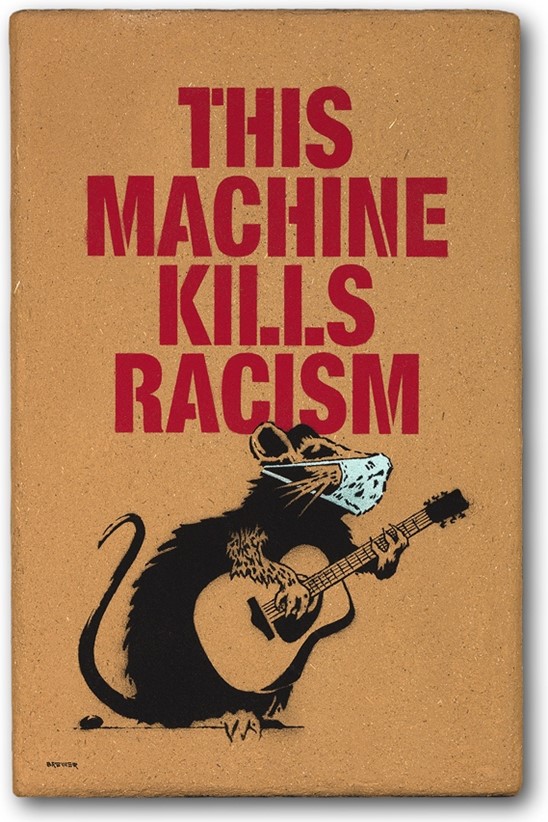calsfoundation@cals.org
Terry Brewer’s Blood and Soil Exhibition on View Now
In this intriguing and timely exhibition, on view through April 7 in the CALS Roberts Library, Galleries at Library Square, artist Terry Brewer takes the hateful rallying cry for racial purity “Blood and Soil!” used in the past by Nazis and in the present by white supremacists and morphs it into the idea of working with both substances as media for thought-provoking art. The paintings on display are mostly rendered with spray-painted stencils to convey a sense of gritty, immediate protest art coupled with themes of ignorance, attachment, and aversion and their opposites: wisdom, generosity, and loving kindness.
***
Brewer writes:
“Blood and soil.” These words have been used by Nazis and others as a rallying cry for racial purity, one of the most destructive concepts ever developed. When they are used as materials for creative expression, however, their elemental beauty lends itself to limitless constructive possibilities. Soil comes from the earth, blood from a sentient being.
The idea of working with blood as a medium came to me around twenty years ago while traveling in South Asia, where the sight of animals being slaughtered for religious rituals or the simple procurement of food is commonplace. The sheer volume spilled from a single creature was a bit shocking at first for this city boy, and the pattern of splattered blood on temple grounds was gruesome indeed. Over time, though, the experience became less startling with familiarity and the taking of delicious meals prepared with it. My relationship with this life force began to change, and I began thinking of it in a more abstract way, seeing its potential for use as a medium for artistic expression. I had never heard of it being done before but wasn’t surprised to learn otherwise. The shock value to the senses is undeniable. It should be handled appropriately and balanced, in my view, by the underlying beauty and naturalness of the substance and the added layer of meaning it can bring to a piece both conceptually and physically.
It was not long after my experiences in South Asia that I learned to make and work with natural plasters as a building material in Taos, New Mexico. The subtle beauty of a skillfully finished wall captured my imagination. Digging and sifting soil from the job site was an added bonus. When I built my own house in southwestern Colorado, the composition of the soil on my land was perfect for natural plaster. While the crucial raw materials for natural plaster are fairly easy to come by whether you dig them up yourself or buy them from a dealer, finding a source for the optional ingredient (blood) that I wanted to use for these pieces proved difficult. Blood has long been added to natural plasters to improve durability, yet after several futile attempts at finding a source, the idea was placed on the back burner but never abandoned.
Fast-forward to 2017 and the Unite the Right rally in Charlottesville, Virginia, where tiki-torch-bearing demonstrators shamelessly chanted “Blood and Soil” and other hateful Nazi slogans for all the world to see. The dormant idea of working with mud and blood was rekindled but this time with a clear purpose: to somehow turn that particular despicable display into something positive or at least an attempt at thought-provoking social commentary. Then came 2020, COVID-19, the George Floyd murder—a time full of problems yet a very fertile time for creatives.
Understanding that the words and materials “blood and soil” lend themselves to conceptually addressing a wide variety of current events and social ills confronting the nation and world writ large, the search began again in earnest. After fruitlessly calling local butchers and slaughterhouses, it dawned on me that if anyone sold blood in the area it would be an Asian market. Sure enough, it’s a common item usually found in the freezer section. With a reliable source located, I began experimenting with various recipes until finally coming up with the colors and textures I was going for.
After seeing what I was up to, a friend suggested I might want to do some work on the 7th Street mural project so I temporarily set these works aside and produced ten different pieces of various sizes down there, most of which have been destroyed outright or damaged and then restored. I think most agree these are difficult and dangerous times that require the participation of all who can lend their voices, whether you are a painter, poet, musician, or patron; regardless of your skill level, the arts have a place in this discussion. As Nina Simone said, “It’s an artist’s duty to reflect the times.”
Visit the Galleries at Library Square to view several exhibitions and shop for books and art:
- Tuesday through Saturday 10 a.m. to 5 p.m.
More visiting info. here: https://robertslibrary.org/visit/location-hours/








